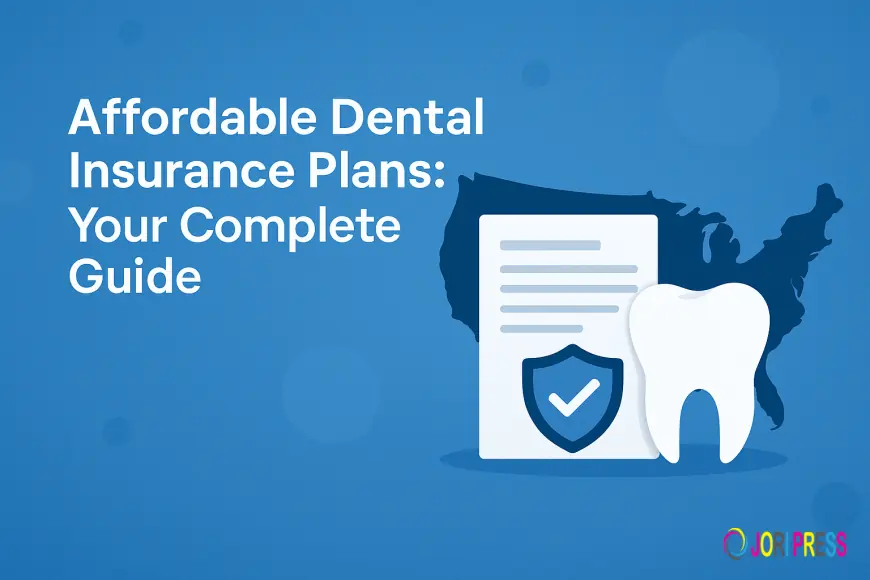Affordable Dental Insurance Plans: Your Complete Guide to Choosing the Best Coverage
Learn how dental insurance works, compare plan types, find low-cost coverage, and choose the best dental plan for your needs with this complete guide.

Dental care is one of the most important parts of your overall health, yet it is often overlooked until pain, sensitivity, or an emergency appears. When that happens, people suddenly discover how costly dental treatments can be—especially without insurance. A single filling, root canal, or crown can cost several hundred to thousands of dollars.
That is why dental insurance matters. It protects you from unexpected expenses, helps you maintain regular checkups, and makes essential treatments more affordable. But with so many plan options available, choosing the right coverage can feel confusing.
This guide explains everything in simple and clear language, helping you understand dental insurance, compare the best plan types, and pick the option that fits your needs and budget.
Why Dental Insurance Is Important
Dental care costs can add up quickly, but insurance reduces a large portion of these expenses. Here are the biggest reasons dental insurance is worth considering:
1. Preventive Care Becomes Affordable
Most dental insurance plans cover preventive services at 100%.
These include:
-
Routine cleanings
-
Oral exams
-
X-rays
-
Fluoride treatments
Preventive visits help catch problems early and prevent expensive procedures in the future.
2. You Get Lower Prices on Basic and Major Care
Without insurance:
-
A simple filling may cost $150–$300
-
A root canal can cost $700–$1,200
-
A crown can range from $800–$2,000
Insurance helps reduce these charges significantly.
3. It Encourages Better Dental Health Overall
Regular visits mean you’re more likely to detect issues early, avoid major work, and maintain a healthier smile.
How Dental Insurance Works
Before comparing plans, it’s helpful to understand a few basic insurance terms:
Premium
Your monthly payment to keep the insurance active.
Deductible
The amount you must pay first before your plan covers certain services.
Copay / Coinsurance
The portion you pay after insurance contributes its share.
Annual Maximum
The maximum amount your dental insurance will pay within a year.
Waiting Period
Some plans require you to wait before receiving coverage for major treatments.
Types of Dental Insurance Plans
Not all dental plans are the same. Here are the most common types you’ll see:
1. PPO (Preferred Provider Organization)
PPO plans are the most popular because they offer flexibility and good coverage.
Advantages:
-
Large network of dentists
-
Coverage for preventive, basic, and major services
-
Many plans offer no waiting period
-
Option to visit out-of-network dentists
Best For:
People who want freedom of choice and broad coverage.
2. HMO (Health Maintenance Organization)
HMO plans are usually the most affordable.
Advantages:
-
Low monthly cost
-
Predictable copays
-
Good for preventive and basic care
Limitations:
-
Must use in-network dentists
-
Limited coverage for major procedures
Best For:
People seeking the lowest price.
3. Dental Discount Plans (Savings Plans)
These are not traditional insurance plans.
How they work:
-
Pay a small yearly or monthly fee
-
Receive 20–60% discounts at participating dentists
-
No waiting periods
-
No deductibles
-
No annual maximum
Best For:
Anyone who needs immediate savings or low-cost options.
4. Indemnity (Fee-for-Service) Plans
These plans offer the most freedom.
Advantages:
-
Visit ANY dentist
-
Insurance reimburses a percentage of cost
-
Good for areas with limited networks
Best For:
People who prefer traditional dentist choice.
What Dental Insurance Usually Covers
Most plans follow a three-level coverage system:
1. Preventive Care – 100% Covered
-
Cleanings
-
Exams
-
X-rays
2. Basic Procedures – 70–80% Covered
-
Fillings
-
Simple extractions
-
Emergency dental care
3. Major Procedures – 40–50% Covered
-
Crowns
-
Root canals
-
Bridges
-
Dentures
-
Oral surgery
Implants
Some plans include coverage, but many don’t. Always check the fine details.
How Much Does Dental Insurance Cost?
The price varies by state, age, and plan type.
Here’s a general average:
-
PPO Plans: $25–$50/month
-
HMO Plans: $15–$25/month
-
Indemnity Plans: $40–$70/month
-
Discount Plans: $10–$15/month
Family plans cost a bit more, depending on the number of members.
Dental Insurance Differences by State
Dental plans are available in all 50 U.S. states, but different states may offer:
-
Larger or smaller dentist networks
-
Different premium ranges
-
Unique local providers
-
Varying major-care coverage options
-
Availability of no-waiting-period plans
If you live in a big state like California, Texas, or Florida, you’ll find more plan options than in smaller states.
How to Choose the Right Dental Insurance Plan
Here is a simple step-by-step method:
Step 1: Identify Your Needs
-
Do you need preventive only?
-
Do you have ongoing dental issues?
-
Do you need crowns, implants, or root canals?
Step 2: Compare Plan Types
PPO for full coverage
HMO for low cost
Discount plan for instant activation
Indemnity for maximum choice
Step 3: Check Waiting Periods
If you need treatment soon, choose no waiting period plans.
Step 4: Confirm Annual Maximum
Higher maximums (like $2,000–$3,000) are better for major dental work.
Step 5: Review the Dentist Network
Make sure your preferred dentist is included.
Step 6: Compare Monthly Costs
Balance premium + deductible + copay to see the real total cost.
Tips to Save Money on Dental Care
-
Always use in-network dentists
-
Don’t skip cleanings; they prevent costly issues
-
Consider discount plans if uninsured
-
Compare at least 3 plans before picking one
-
Ask your dentist about in-office savings programs
Common Myths About Dental Insurance
Myth 1: All plans cover implants
Only some do. Always check the major-care section.
Myth 2: Dental insurance is too expensive
Many affordable plans start at just $15–$25 per month.
Myth 3: You don’t need insurance if you brush well
Even healthy teeth require professional cleanings.
Frequently Asked Questions
1. What is the cheapest dental insurance plan?
Basic HMO plans and discount dental plans offer the lowest cost.
2. Can I get dental insurance with no waiting period?
Yes. Many PPO and discount plans provide instant coverage.
3. Does dental insurance cover implants?
Some plans do, but not all. Always review major-care benefits.
4. Are dental plans available in every state?
Yes. Dental insurance options are available nationwide.
5. Is dental insurance worth it?
Yes. Preventive visits alone often cost more than a year’s premium.
Final Thoughts
Dental insurance is an essential tool for managing dental health, protecting your finances, and ensuring you receive the care you need before problems become serious. With so many options—PPO, HMO, discount plans, and indemnity—you can easily find coverage that fits both your dental needs and your budget.
Use this guide as your go-to resource for understanding how dental insurance works and choosing the right plan with confidence.
What's Your Reaction?
 Like
0
Like
0
 Dislike
0
Dislike
0
 Love
0
Love
0
 Funny
0
Funny
0
 Angry
0
Angry
0
 Sad
0
Sad
0
 Wow
0
Wow
0




















































